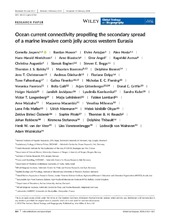| dc.contributor.author | Jaspers, Cornelia | |
| dc.contributor.author | Huwer, Bastian | |
| dc.contributor.author | Antajan, Elvire | |
| dc.contributor.author | Hosia, Aino | |
| dc.contributor.author | Hinrichsen, Hans-Harald | |
| dc.contributor.author | Biastoch, Arne | |
| dc.contributor.author | Angel, Dror | |
| dc.contributor.author | Asmus, Ragnhild | |
| dc.contributor.author | Augustin, Christina | |
| dc.contributor.author | Bagheri, Siamak | |
| dc.contributor.author | Beggs, Steven E. | |
| dc.contributor.author | Balsby, Thorsten J.S. | |
| dc.contributor.author | Boersma, Maarten | |
| dc.contributor.author | Bonnet, Delphine | |
| dc.contributor.author | Christensen, Jens T. | |
| dc.contributor.author | Dänhardt, Andreas | |
| dc.contributor.author | Delpy, Floriane | |
| dc.contributor.author | Falkenhaug, Tone | |
| dc.contributor.author | Finenko, Galina | |
| dc.contributor.author | Fleming, Nicholas E.C. | |
| dc.contributor.author | Fuentes, Veronica | |
| dc.contributor.author | Galil, Bella S. | |
| dc.contributor.author | Gittenberger, Arjan | |
| dc.contributor.author | Griffin, Donal C. | |
| dc.contributor.author | Haslob, Holger | |
| dc.contributor.author | Javidpour, Jamileh | |
| dc.contributor.author | Kamburska, Lyudmila | |
| dc.contributor.author | Kube, Sandra | |
| dc.contributor.author | Langenberg, Victor | |
| dc.contributor.author | Lehtiniemi, Maiju | |
| dc.contributor.author | Lombard, Fabien | |
| dc.contributor.author | Malzahn, Arne | |
| dc.contributor.author | Marambio, Macarena | |
| dc.contributor.author | Mihneva, Veselina | |
| dc.contributor.author | Møller, Lene Friis | |
| dc.contributor.author | Niermann, Ulrich | |
| dc.contributor.author | Okyar, Melek Isinibilir | |
| dc.contributor.author | Ôzdemir, Zekiye Birinci | |
| dc.contributor.author | Pitois, Sophie | |
| dc.contributor.author | Reusch, Thorsten B.H. | |
| dc.contributor.author | Robbens, Johan | |
| dc.contributor.author | Stefanova, Kremena | |
| dc.contributor.author | Thibault, Delphine | |
| dc.contributor.author | van der Veer, Henk W. | |
| dc.contributor.author | Vansteenbrugge, Lies | |
| dc.contributor.author | van Walraven, Lodewijk | |
| dc.contributor.author | Woźniczka, Adam | |
| dc.date.accessioned | 2019-02-20T16:41:04Z | |
| dc.date.available | 2019-02-20T16:41:04Z | |
| dc.date.issued | 2018-07-24 | |
| dc.Published | Jaspers C, Huwer B, Antajan E, Hosia A, Hinrichsen H, Biastoch A, Angel D, Asmus R, et al. Ocean current connectivity propelling the secondary spread of a marine invasive comb jelly across western Eurasia. Global Ecology and Biogeography. 2018;27(7):814-827 | eng |
| dc.identifier.issn | 1466-8238 | |
| dc.identifier.issn | 1466-822X | |
| dc.identifier.uri | https://hdl.handle.net/1956/19124 | |
| dc.description.abstract | Aim: Invasive species are of increasing global concern. Nevertheless, the mechanisms driving further distribution after the initial establishment of non‐native species remain largely unresolved, especially in marine systems. Ocean currents can be a major driver governing range occupancy, but this has not been accounted for in most invasion ecology studies so far. We investigate how well initial establishment areas are interconnected to later occupancy regions to test for the potential role of ocean currents driving secondary spread dynamics in order to infer invasion corridors and the source–sink dynamics of a non‐native holoplanktonic biological probe species on a continental scale. Location: Western Eurasia. Time period: 1980s–2016. Major taxa studied: ‘Comb jelly’ Mnemiopsis leidyi. Methods: Based on 12,400 geo‐referenced occurrence data, we reconstruct the invasion history of M. leidyi in western Eurasia. We model ocean currents and calculate their stability to match the temporal and spatial spread dynamics with large‐scale connectivity patterns via ocean currents. Additionally, genetic markers are used to test the predicted connectivity between subpopulations. Results: Ocean currents can explain secondary spread dynamics, matching observed range expansions and the timing of first occurrence of our holoplanktonic non‐native biological probe species, leading to invasion corridors in western Eurasia. In northern Europe, regional extinctions after cold winters were followed by rapid recolonizations at a speed of up to 2,000 km per season. Source areas hosting year‐round populations in highly interconnected regions can re‐seed genotypes over large distances after local extinctions. Main conclusions: Although the release of ballast water from container ships may contribute to the dispersal of non‐native species, our results highlight the importance of ocean currents driving secondary spread dynamics. Highly interconnected areas hosting invasive species are crucial for secondary spread dynamics on a continental scale. Invasion risk assessments should consider large‐scale connectivity patterns and the potential source regions of non‐native marine species. | en_US |
| dc.language.iso | eng | eng |
| dc.publisher | Wiley | eng |
| dc.relation.uri | https://doi.org/10.1111/geb.12742 | |
| dc.rights | Attribution CC BY-NC | eng |
| dc.rights.uri | http://creativecommons.org/licenses/by-nc/4.0/ | eng |
| dc.subject | biological invasions | eng |
| dc.subject | gelatinous zooplankton | eng |
| dc.subject | invasion corridors | eng |
| dc.subject | invasive species | eng |
| dc.subject | jellyfish | eng |
| dc.subject | marine connectivity | eng |
| dc.subject | Mnemiopsis leidyi | eng |
| dc.subject | range expansion | eng |
| dc.subject | source populations | eng |
| dc.subject | source–sink dynamics | eng |
| dc.title | Ocean current connectivity propelling the secondary spread of a marine invasive comb jelly across western Eurasia | eng |
| dc.type | Peer reviewed | en_US |
| dc.type | Journal article | en_US |
| dc.date.updated | 2018-10-08T11:11:09Z | |
| dc.description.version | publishedVersion | |
| dc.rights.holder | Copyright 2018 The Authors | eng |
| dc.identifier.doi | https://doi.org/10.1111/geb.12742 | |
| dc.identifier.cristin | 1593854 | |
| dc.source.journal | Global Ecology and Biogeography | |
| dc.relation.project | Norges forskningsråd: 190304 | |

